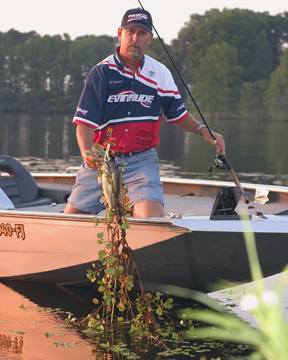
Sid Havard made a cast down the side of a floating log that was partially enshrouded by the low-hanging branches of a group of cypress trees. He immediately lifted the tip of his rod and started reeling. The plastic frog he was fishing began gurgling beside the log. Unbeknownst to Havard, there was another pair of eyes watching the fake frog. A great blue herron was perched on a section of the log that was hidden by the limbs. Deciding to not let this easy meal pass by, the bird thrust itself into the water and grabbed the sure treat.
“That was the craziest thing I think I’ve ever seen,” Havard said. “That bird actually ate the frog and took off. I didn’t know what to do. I started shaking my rod to try to get the frog out of its mouth, but he wouldn’t let go. The bird actually started flying off with my bait in its mouth. I shook it a few more times, and finally got that bird to drop it. That just goes to show you just how realistic these new fake frogs really are.”
Some of the most popular new frogs are the ReAction Ribbit, Zoom Horney Toad and the Sizmic Sassy Toad. These lures give anglers the same drawing capabilities of a buzz bait with the luxury of being able to put the lure absolutely anywhere without the fear of getting hung.
“I got turned on to the Ribbit last year,” Havard said. “What I love most about it is that I can get away with throwing it in places where I can’t throw anything else. These frogs are widely considered as great grass baits, but you can reel it through laydowns and flooded brush – it just won’t hang up.”
Havard said it is important to rig the hook through the frog in the traditional Texas-rigged method.
“You want to go through the nose about a quarter of an inch and rig the hook all the way through the body of the frog back between its legs. The Ribbit has a little groove in its back that the point will sit in when rigged properly. In fact, just as a precaution, I’ll pinch the back of the frog over the hook point to make it totally weedless.”
“Grass has to be the No. 1 cover for frog fishing,” Havard continued. “And there are several key spots within a grass bed that are likely to hold fish.”
The first area Havard looks for is a stretch of open water between the grass and the bank. This kind of area gets little pressure from anglers throwing traditional grass lures, and it can hold some big bass.
“I like to throw the frog up on the bank and crawl it into the water,” he said. “Any bass within sight or sound of it can’t stand it – he’s got to eat that frog.”
Other potential areas within a grass bed are points, indentations and holes. The key to fishing any of these spots is to cast past it so the fish can track it to the hot zone.
“You’ve got to cast way up on the grass and get the frog coming to you,” he said. “Any fish that’s around is going to start following that commotion, and if he decides to eat, he’ll strike as soon as the frog gets to an open edge.”


